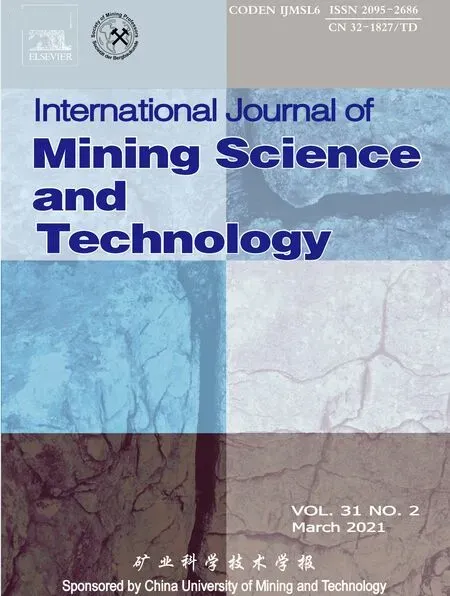A novel coating technology for fast sealing of air leakage in underground coal mines
2021-04-08SihuShoChunleiWuMinHoXiolinSongXueyouSuWeihnWngGuoshengLiBooShi
Sihu Sho,Chunlei Wu,Min Ho,Xiolin Song,Xueyou Su,Weihn Wng,Guosheng Li,Boo Shi,*
a Jiangsu Key Laboratory of Fire Safety in Urban Underground Space,China University of Mining and Technology,Xuzhou 221116,China
b Dashuitou Coal Mine,Gansu Jingyuan Coal and Electricity Co.,Ltd.,Baiyin 730913,China
Keywords:Spontaneous combustion Air leakage prevention Roadway spraying Novel coating technology
ABSTRACT Air leakage in underground coal mines presents a serious hazard for coal production and the safety of miners.Coating technology is commonly used as an efficient means for preventing air leakage.To address existing problems with high dust concentrations in large operations involving complex processes and the high cost of traditional coating technology,a novel coating technology that ensures intrinsic safety by utilizing water pressure and wind pressure was developed.This new coating technology was designed to suction and spray,and the technical parameters of its spray performance was also studied.The experimental tests and evaluation indicated the optimum working range is 0.3-0.7 MPa of wind pressure,1.2-10.2 L/min of water quantity,and 1.0-3.5 m of spraying distance.Moreover,this novel coating technology was tested in the Dashuitou Coal Mine in Gansu Province of China.Compared with conventional counterparts,the proposed new technology is safe,efficient,and convenient to operate.During spraying,dust concentrations were kept at less than 10 mg/m3,and the average rebound ratio resilient rate of solid materials was below 13%.After spraying,the average leakage every 100 m was 4 m3/min,and the oxygen volume fraction in the adjacent goaf was approximately 4%,demonstrating excellent air leakage prevention.
1.Introduction
Spontaneous coal combustion,one of the main natural disasters in coal mines,has long been known to be responsible for heavy casualties and huge property losses [1,2].Coal fires occur frequently in passage areas with air leakage,such as in goaf,openoff cut,stopping lines,and geologic tectonic zones[3,4].Air leakage from differential pressure and fractures induces coal-oxygen interactions,and the heat generated by coal-oxygen reaction cannot be dissipated in time,which makes the temperature of coal rise gradually and finally leads to coal spontaneous combustion.Annual coal losses caused by spontaneous coal combustion can be as high as 10-20 million tons[5],which not only affects the quality of coal,but also releases greenhouse gases that pollute the atmosphere[6-8].Therefore,the investigation of technical measures to prevent air leakage has always been the focus of research effort.
There are many methods for sealing air to prevent spontaneous coal combustion,such as reducing differential pressure on both sides of the coal wall (balance their pressure to prevent coal fire)and plugging air leakage cracks using polyurethane foam and organic solidified foam [9].Among these methods,the coating technology is commonly utilized in China to prevent air leakage in the roadway of coal mines because of the low workload involved and its high efficiency[10].Roadway spraying can reduce air leakage in roadways,prevent low-temperature oxidation by broken coal,and minimize a spontaneous coal combustion in the goaf and roadway roof caving zone.Spraying coal pillars can block the development of cracks in the coal wall,weaken coal wall oxidation,and ensure safe mining in an area.However,high dust concentrations in large operations involving complex processes and high cost of the coating device can severely limit the application of coating technology in coal mines.
In this paper,in order to solve the problems of high dust concentrations in large operations involving complex processes and high cost of traditional coating technology,the authors developed a novel coating technology that ensures intrinsic safety by utilizing water pressure and wind pressure.Compared with conventional counterparts,the proposed new technology has a simplified structure with the advantages of being safe,efficient,and convenient to operate.
2.Development and testing of novel coating technology
2.1.Introduction of coating technology
A novel coating technology that utilizes water and wind pressure to spray slurry onto the surface of the roadway in coal mines in order to prevent air leakage was proposed.Fig.1 illustrates the proposed system for the novel coating technology,which consists of three parts i.e.absorption,transportation,and spray components.
The absorption component consists of an air compressor or compressed air pipeline (0.3-0.8 MPa),a pneumatic exhaust(XFCF-150 V),and a feeding device.This component is convenient to carry and safe to operate on-site with reduced cost of equipment and labor to ensure intrinsic security.In addition,the flow absorbability flow of the pneumatic exhaust can be controlled,the parameters of the process adjusted,and the spraying effect improved by adjusting the pressure regulating valve of the air-compressed equipment.
The transportation component,i.e.a deformation-free noncrushable plastic steel reinforced hose (32 mm in diameter),can adjust the direction and distance of the spray and convey spray material mixed with high pressure gas.
The spray component consists of a self-designed made spray gun,wetting/atomizing nozzles,and water pump/water pressure pipelines (with 80 m lift).By adjusting the water pressure valve,the wetting/atomizing nozzles can generate an atomizing effect under high water pressure,wetting dry powder fully from the sprayed output,making it wet and sticky in the specified area.Moreover,when atomization is achieved,a spraying-induced suction is formed when the spray radius equals or is larger than the inner diameter of the pipe [11].Negative pressure formed in the atomized field means dusty airflow can be inhaled,which purifies the operating environment [11].
2.2.Equipment
2.2.1.Pneumatic exhaust
The pneumatic exhaust(Xuanfeng Fluid Technology,Shenzhen,China)used in the proposed novel technology can generate strong absorbability (similar to a tornado’s pneumatic principle) to achieve the effect of a strong blade suction fan that consumes a small amount of compressed air.Moreover,the pneumatic exhaust is small in size,with no moving parts and an unobstructed air flow channel (e.g.fan blade and motor).The absorbability of the pneumatic exhaust increases with an increase in gas consumption and its maximum absorbability is -30kPa,which is suitable for absorbing solid material particles.The structure of the pneumatic exhaust is illustrated in Fig.2.
The pneumatic exhaust is used widely in many applications,such as conveying particle materials,absorbing industrial dust,supplying air,and moving exhaust smoke;its application in spraying an underground coal mine,however,is a first.The pneumatic exhaust has the following characteristics.(1) It has a compact structure and a small volume,and is lightweight and simple to operate and convenient to transport.(2) It uses compressed air as power,has no moving parts,poses no fire danger,and is highly secure and reliable.(3) It facilitates control of air velocity and strength,consumes less gas,and has unobstructed airflow passage.It was concluded that the pneumatic exhaust has the potential to transport materials in underground coal mines.
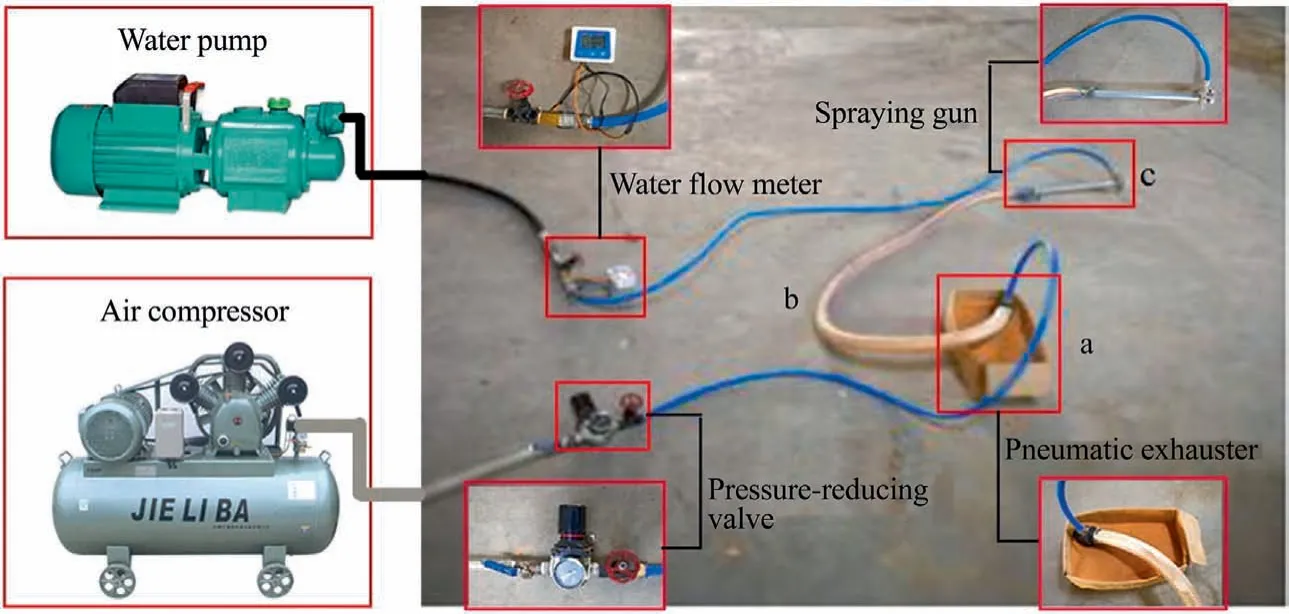
Fig.1.Schematic diagram of the novel coating technology.

Fig.2.Structure of the pneumatic exhaust.
The structure and performance parameters of different types of pneumatic exhausts were surveyed and investigated.Table 1 lists the structural parameters of the pneumatic exhaust that can optimize spraying function.Fig.3 demonstrates the performance parameters of the pneumatic exhaust.With the model types increasing,the vacuum degree decreases and the air flow increases.
According to structural parameters and the performance of the pneumatic exhaust (Fig.3c),the line of exhausted air is always below the two lines of air displacement and air consumption,indicating that the XFCF-150 V is more efficient.Besides,due to its larger suction under negative pressure and higher absorption flowrate,XFCF-150 V pneumatic exhaust was selected for this experiment.To further understand its conveying performance,clay was used as experimental spraying material and the effect of different wind pressure on the conveying performance of the XFCF-150 V pneumatic exhaust was studied.

Table 1 Structural parameters of different types of pneumatic exhaust.
The mass flow of the pneumatic exhaust,namely its absorbability,determines the spraying efficiency of the spraying equipment.Fig.4 shows the change in mass flow of sprayed material under different wind pressures and under limited experimental conditions.The wind pressure ranged from 0.3 to 0.8 MPa.As the wind pressure increased,the mass flow of spraying material increased gradually,but the rate of its increase decreased continuously until almost coming to a plateau (see Table 2).
Fig.5 shows the wind velocity at different distance points under different wind pressure.As can be seen from Fig.5,under constant wind pressure the wind velocity decreases with the distance extending from the spraying outlet (1,2,3,and 4 m).As the wind pressure increases from 0.3 to 0.8 MPa,the wind velocity increases rapidly.The reasonable spraying distance of the novel spraying technology is primarily determined by wind pressure.
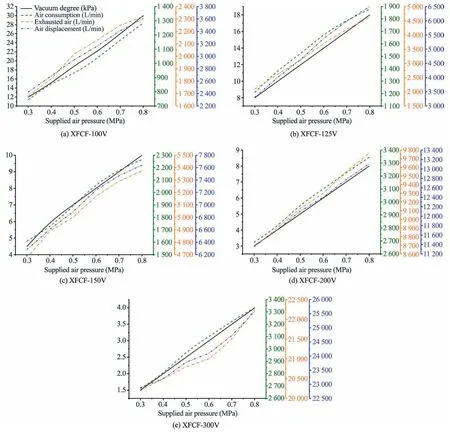
Fig.3.Performance of different types of pneumatic exhaust with a range of parameters.
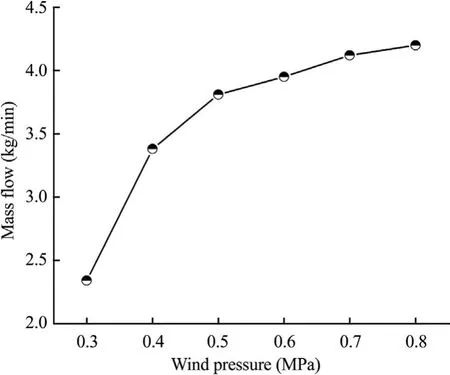
Fig.4.The mass flow under different wind pressure.

Table 2 Mass flow rate with the increase of wind pressure.
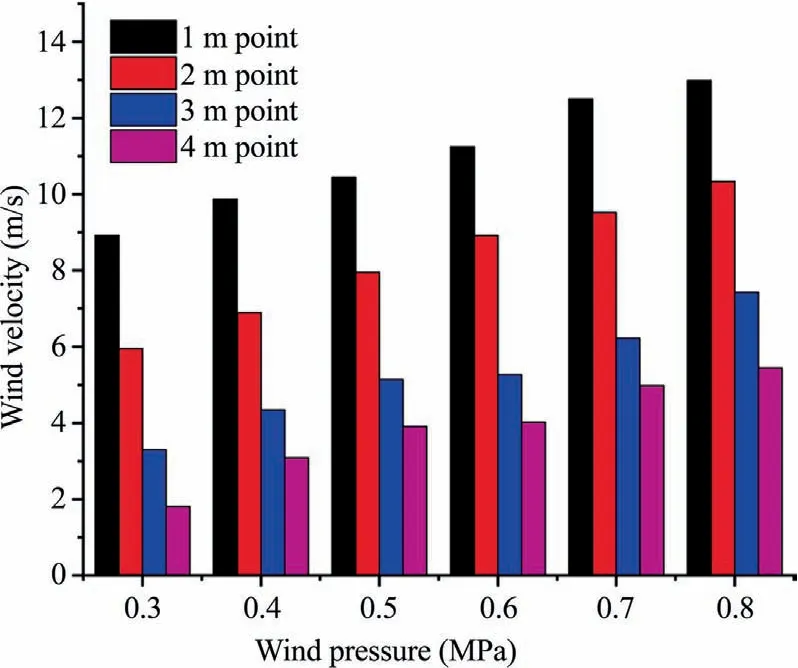
Fig.5.The wind velocity at different distance points under different wind pressure.
2.2.2.Wetting/atomizing nozzles
The wetting/atomizing nozzle is a fundamental element of the spraying gun,and its atomizing performance (i.e.atomizing field and droplet size) will directly determine the coating effect and the wettability of particle material [12,13].
The nozzles made of polyvinylidene fluoride (PVDF) with three joint size types of 1/8′,1/4′,and 3/8′were used to wet spray material by atomization(Table 3).The shape of the spray is a solid cone,and the spayed surface is round and the coverage area is more uniform.The droplet diameter is medium,and the unique blade design and flow channel provide excellent control and uniform spray distribution (Fig.6).
The atomization by the nozzles was measured at different rates of water flow(2-11 L/min)through the water pump(single-phase screw self-priming pump with the lift of 80 m).The spray range of the nozzles and the atomization distance play important roles in the atomizing wetting process.By testing the radius of the spray area and evaluating the atomization distance,a suitable nozzle type for the spraying process was chosen.(Testing method:Under the condition of the same water flow rate,different types of nozzles are used to spray the solution vertically to the flat board at a certain distance.A suitable nozzle type can be obtained by measuring the diameter of the circular spraying area formed by the water solution on the board.)
Fig.7 shows the atomization distance and diameter of different nozzles under different water flow.As shown in Fig.7,the atomizing distance and diameter of different nozzles both increased when the water flow increased from 2 to 11 L/min.The atomizing distance and diameter of nozzles determine the wetting effect of the spray and therefore the dust removal effect.The water flow of the nozzles needs to match the material absorption of the pneumatic exhaust.Meanwhile,given their atomizing distance and diameter,the KY nozzles with joint size types of 1/4′were employed in the novel spaying technology.The four nozzles were set on the outlet of the designed spray gun in accordance with the square shape,which can fully wet sprayed materials (Fig.8).
2.3.Procedure for the technology
The specific operational procedure of the novel technology is as follows.
(1) Inspect and connect the system equipment:check failure conditions for air pressure and water pressure pipeline,prepare spraying materials,and connect the spraying equipment to ensure the spraying system is normal;
(2) Debug the process parameter:adjust the valves of the wind pressure and water pressure pipeline,observe changes in wind pressure and water flow parameters,keep the parameters within optimal working range,and test the spraying effect;
(3) Spray a region:move the spraying system to a preset spray area,evenly spray to ensure continuity of the spraying operation;

Table 3 Performance of different types of nozzle.
(4) Remove and refurbish the system equipment:after the preset area has been sprayed,move the spray equipment to the next area to be sprayed (or alternatively dismantle and maintain the system equipment).
In order to evenly spray onto the roadway wall,the spray gun should be slowly moved forward along a spiral path (approximately 0.5-0.7 m in diameter) while spraying (Fig.9).The thickness of the coating is generally 3-5 cm and can change depending on the conditions.
2.4.Performance testing
2.4.1.Test methods
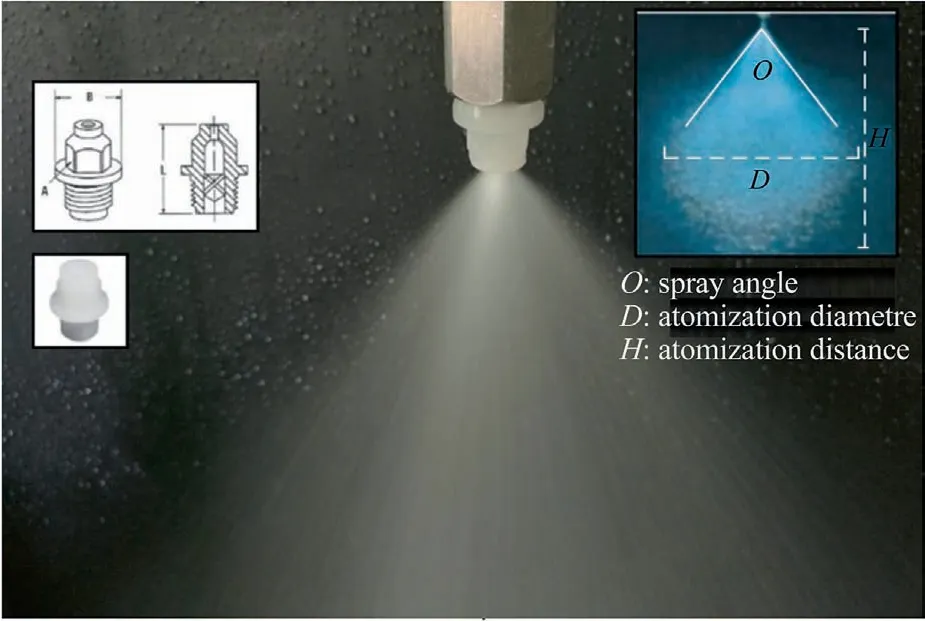
Fig.6.Types of the nozzle used in the experiments.
The experimental arrangement to test the performance of the designed spray technology system is illustrated in Fig.10.In the spraying test site,the controllable parameters are mainly wind pressure(P),the mass flow rate of solid materials(M),and the rate of water flow (L).In this paper,the influence of these parameters on spraying performance was studied to guide the engineering of technological parameters in practice.Because of the limitations of the experimental system,the ranges of experimental parameters are shown in Table 4.Table 5 shows the main characteristics of the solid spray materials used in this study.
The experimental procedure was as follows.
(1) Close ball valve I and adjust the pressure regulator so that the pressure gauge indicates the required pressure.Open ball valve I and convert the pressure value into the corresponding mass flow rate of solid materials.
(2) Turn on the water pump,adjust ball valve II to observe the wetting effect of solid materials in spraying gun outlet until spray performance is optimal.

Fig.7.Atomization distance and diameter of different nozzles under different water flow.

Fig.8.Design drawing of the self-designed spraying gun.

Fig.9.Schematic diagram of the spray path.
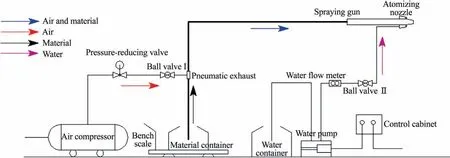
Fig.10.Experimental arrangement to test the performance of the novel spraying technology.

Table 4 Ranges of experimental parameters.

Table 5 Physical properties of the solid material (clay).
(3) Test spray distance and dust concentration in spray area,and record the corresponding instrument data.
2.4.2.Result
The two main performance parameters,i.e.the dust concentration and rebound ratio,are considered as evaluation indices of the spray effect.The optimum working range of the novel spraying technology is obtained through the process of debugging the equipment’s parameters (Table 6).
3.Field application
To test and evaluate the spraying effect of the novel coating technology,a field test was performed.
3.1.Test site
The Dashuitou Coal Mine is located southwest of the Dabao syncline 69 km away from Baiyin City in Gansu Province of China.This mine field’s strike length is 8.9 km,its tendency length is 2.5 km,the average area of mining rights is 14.3 km2and the mining depth is 1600-930 m,affiliated with the Jingyuan Coal Industry Group.The mine is ventilated with two-wing diagonal ventilation,the roadway has positive pressure ventilation,and the working face has negative pressure ventilation.The spontaneous combustion tendency is ‘‘self-ignition”(the grade of spontaneous combustion being the highest level in China) and the spontaneous combustion period measured on the site is 3-6 months.It was determined thatthe east wind roadway in the coal mine would be the test site for a comparative trial.

Table 6 Optimum working range of the novel spraying technology.

Fig.11.Contrast in the performance of the two spraying equipments.
3.2.Test layout
Two areas along the 1191 gob-side entry retaining were chosen to be comparative trial sites,with the height and length of 5 and 50 m,respectively.The distance between the two test areas is 100 m,which are denoted as Area I (test site for the traditional equipment)and Area II(test site for the novel equipment),respectively.The test areas were sprayed using the same solid materials.Dust concentrations for each area were monitored at four sample points(5,15,30,and 50 m from the spraying area)during spraying.After spraying,the resilient rate of solid materials in each area was measured.The field application diagrams of the traditional and novel technologies can be seen in Fig.11.
3.3.Test results and discussion
The results of the comparative trial are presented in Fig.12.Notable differences in dust concentration and the resilient rate of solid materials were found between the traditional equipment and the novel equipment.The comparative trial revealed the average dust concentration from the novel spray technology was less than 10 mg/m3,lower than that of the traditional spray.Likewise,the resilient rate of solid materials in Area II was evidently less than that in Area I.
As for the spray effect of the new technology,the average leakage air volume every 100 m and the oxygen volume fraction in the adjacent goaf were selected to be indicators for the effectiveness of leakage from wind.
Fig.13 shows the amount of wind at selected measuring points along the roadway of 1191 gob-side entry retaining,and the average leakage air volume per 100 m(Q100)was calculated to be 4 m3/min.After roadway spraying,oxygen volume fraction adjacent to the goaf decreased rapidly from 15% to 4%,which demonstrates an excellent effect of wind plugging and can prevent spontaneous coal combustion.
4.Conclusion
To improve the performance of spraying and overcome deficiencies in existing technology,a novel coating technology is proposed for sealing air to efficiently prevent and control the spontaneous coal combustion in goafs and roadways.The equipment and technical parameters of this novel technology were studied.The new technology was tested in the Dashuitou Coal Mine in Gansu Province of China.The results are as follows.
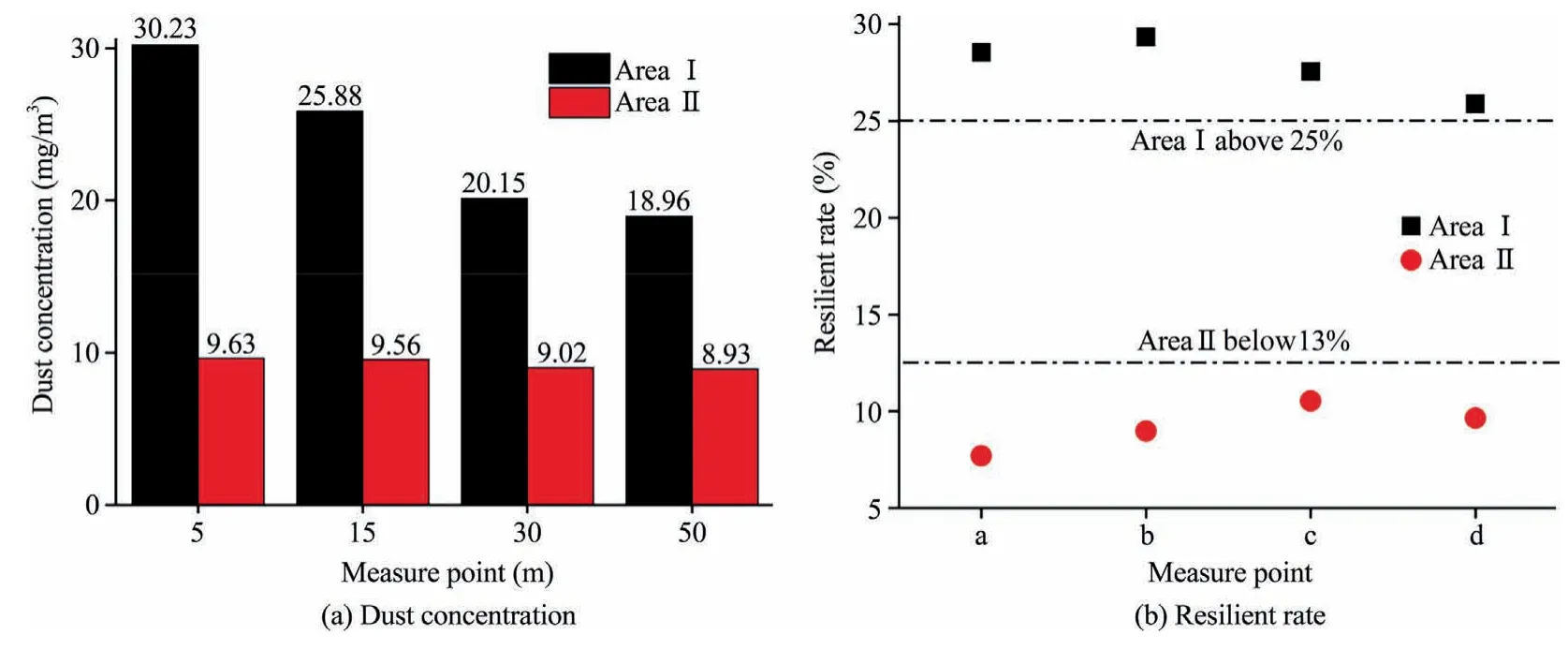
Fig.12.Performance of both spray technologies in the comparative trial.Note that the resilient rate is the ratio of the total amount of sprayed materials that rebound to the ground to the total amount of sprayed materials.
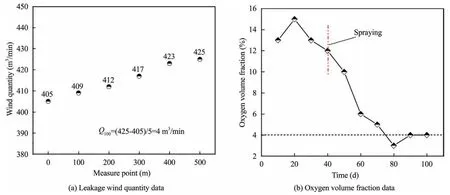
Fig.13.Spray performance of the new technology.
(1) The novel spraying technology can efficiently accomplish the three processes of suction,conveyance,and spray.With the advantages of a simplified structure and safe and convenient operation,it was found to be suitable for air sealing in underground coal mines.
(2) The optimum working range of the novel spraying technology is 0.3-0.7 MPa of the wind pressure,1.2-10.2 L/min of the water flow,and 1.0-3.5 m of the spray distance.In this working range,this novel spraying technology performs optimally with low dust concentrations and low resilient rate.
(3) As for the performance-wise,the novel equipment compares favorably against the conventional equipment.Dust concentrations are maintained at less than 10 mg/m3during spray,effectively relieving the dust concentrations in large operations and improving the operation of the sprayed environment.The average rebound ratio of solid materials is below 9%,so the costs of spray materials are minimized and the spraying efficiency improved.After spraying by the new technology,the average leakage air volume within 100 m is 4 m3/min,and the oxygen volume fraction in the adjacent goaf is approximately 4%,which demonstrate excellent wind plugging effect and can prevent spontaneous coal combustion.
Acknowledgements
This work is supported by the National Natural Science Foundation of China(Grant No.51704283),Natural Science Foundation of Jiangsu Province (BK20170277),Program for Changjiang Scholars and Innovative Research Team in University (IRT_17R103),and the Fundamental Research Funds for the Central Universities(2014XT02).
杂志排行
矿业科学技术学报的其它文章
- Evaluation of the use of sublevel open stoping in the mining of moderately dipping medium-thick orebodies
- Stability control of gob-side entry retained under the gob with close distance coal seams
- A robust approach to identify roof bolts in 3D point cloud data captured from a mobile laser scanner
- Physical model test and numerical simulation on the failure mechanism of the roadway in layered soft rocks
- Deformation response of roof in solid backfilling coal mining based on viscoelastic properties of waste gangue
- Blast-induced ground vibration prediction in granite quarries:Anapplication of gene expression programming,ANFIS,and sine cosine algorithm optimized ANN
